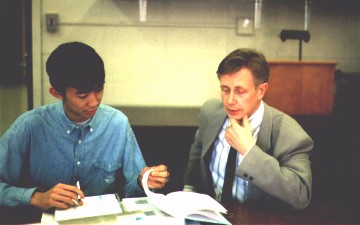
 |
International Mathematica Symposium Brings Together Users of Diverse Fields |
|
The First International Mathematica Symposium, held in Southampton, England on July 16-20, 1995, brought together Mathematica users from many diverse fields, including science, mathematics, technology, business, and education. This
event was attended by over 100 participants from 17 countries. The symposium composed of many keynote lectures, tutorials, and paper presentations. Among the featured speakers were Stephen Wolfram, of Wolfram Research, the creator of Mathematica, who spoke about computation with Mathematica, and the history of abstraction. Roman Maeder, ETH Zurich, Switzerland spoke about term r ewriting and programming paradigms. James Davenport of the University of Bath, spoke about mathematics and computer algebra. Allan Hays, of the University of De Montfort spoke about Mathematica and People: making the future. Jerome Condor, of MIT spoke about the symbolic computational mechanics. In addition, there were tutorials, panels, and problem solving clinics to help ordinary users exploit the enormous power of Mathematica. Among the covered topics were programming in Mathematica, Mathematica graphics, problem solving in Mathematica, and object-oriented programming. Professor Gautam Dasgupta, a professor of civil engineering at the School of Engineering and Applied Science (SEAS) at Columbia University, said that he was excited by the diversity of fields which make use of Mathematica. He was loo king for a computational mathematics program for a long time. Such a program just did not exist 10 years ago. Professor Dasgupta is interested in using Mathematica as a teaching tool. He occasionally gives a one-day introduction to Mathematica to stude nts interested in the program.
| |
 
|

|
|
In a paper presented at the Symposium, professors at the Tampere University of Technology talked about Mathematica in use as part of a hypermedia learning environment. Mathematics can be taught via hypermedia, which is combination of
a database of information (hypertext), and graphics, animation, digitized videos and sounds. The environment works interactively with the student. First, there is a generating program which creates the values used in an numerical problem. Then it form
ulates the actual problem. There is an "exercise maker", which handles all the interaction with the students. After a response is entered by the student, the verifying program checks to see if the student's entered value is correct. Both the generating and the verifying program relies on the computation by Mathematica's kernel. The future g oal of this project is to assess the mathematical knowledge of students. The question and answer technique will hopefully serve as an intelligent tutoring system that points out parts of the materials which could be studied in greater detail. In another paper, by professors at Western Michigan University, proposed a design to build toolsets from the Mathematica programming language to help first-year engineering students to better understand engineering design problems. M any design problems involve the knowledge of advanced mathematics, such as Laplace transforms and complex variables analysis, which is taught in later years. They hope to create instructional tools which allow freshman to understand the fundamental conce pts of engineering which having to delve into great mathematical complexity.
| |

|
Useful Math Resources Calculus & Mathematica Home Page Mathematica - Local Guide WWWMath Discussion Group Page Mathematica at Yale |
 |
| Moment Home Page |
Current Article Index |
Search |
Back Issues |